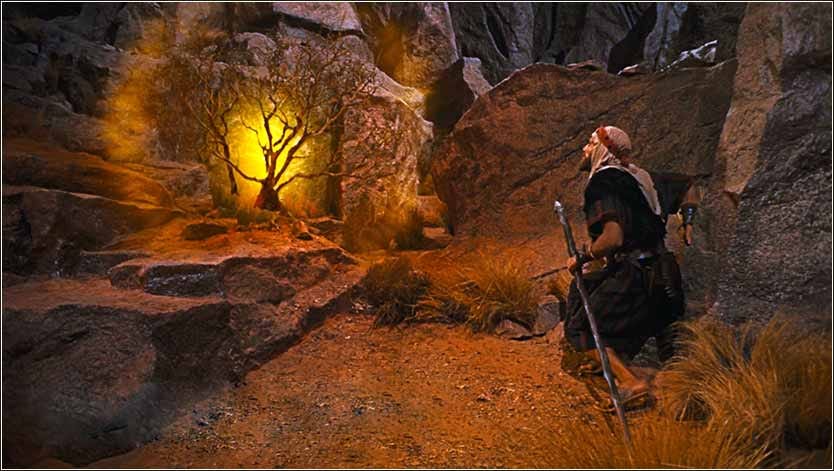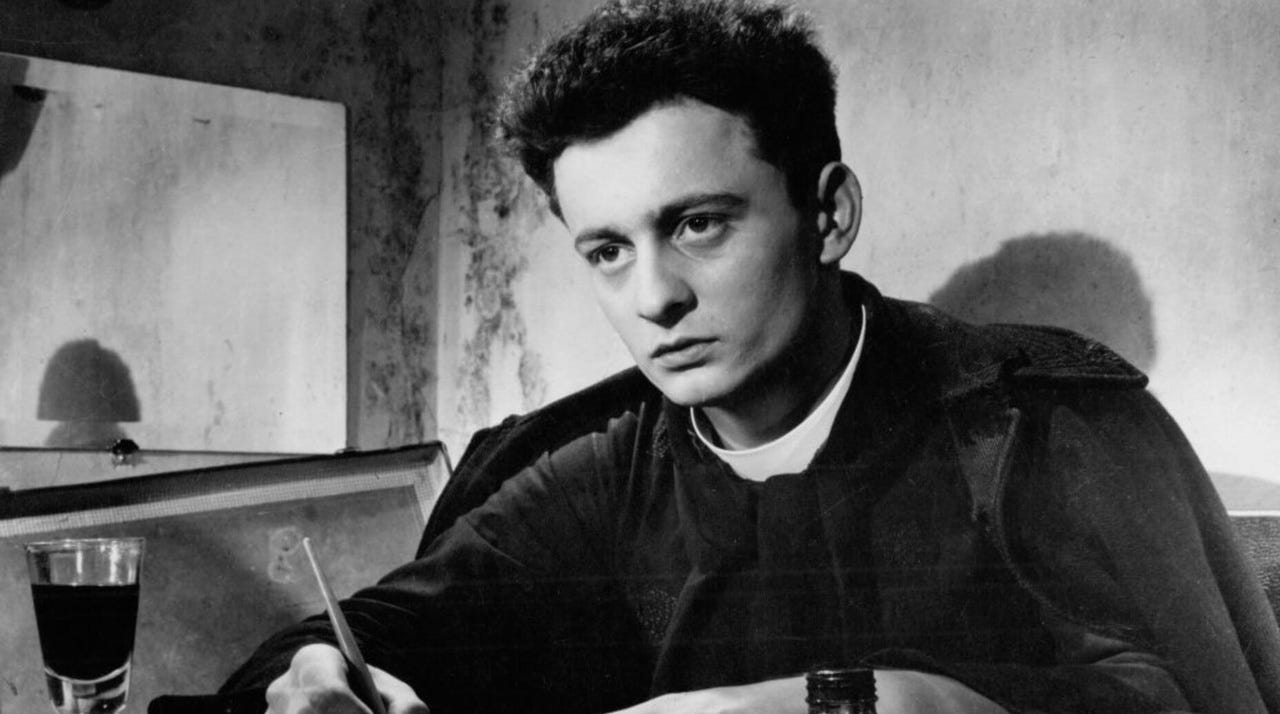Early in the Coen brothers’ Hail Caesar! (2016), 1950s Hollywood fixer Eddie Mannix (Josh Brolin) watches dailies for the titular movie-within-a-movie. It’s a sword-and-sandals epic about a Roman centurion who has a transformative encounter with Christ, which bears more than a little likeness to William Wyler’s Ben-Hur (1958)1 or Mervyn LeRoy’s Quo Vadis (1951). Mannix watches a scene portraying Saul of Tarsus’ own encounter with Christ on the road to Damascus – except every time something godly is supposed to happen, a title card appears: DIVINE PRESENCE TO BE SHOT. We never actually see the finished special effects. In fact, we only glimpse the actor playing Christ from behind, and a brief glimpse of his feet on the cross.2 These moments are all visual gags, to a degree, but they also get at the Coens’ interest in what can and can’t be expressed through film, and where people locate meaning.
This isn’t a piece about God in the Coens’ filmography (although, I’m going to be honest with you, it’s only a matter of time) but it connects to what I’m interested in: is it possible to depict the divine on film?
The easy and mostly correct answer is no, because you can’t really depict the divine in general. God is, in some essential ways, incomprehensible. Mystical experiences defy our attempts to express them in language: we can get close, but we can never express the fullness of a divine encounter to another person in all of its power and significance. There’s a word for that: ineffability.
I’m over at America Magazine this week writing about exactly that topic in my column on Close Encounters of the Third Kind (1978), and it got me thinking about film’s attempts to express the ineffable as an artform. If any artform can, it’s music (notably, an important plot element in Close Encounters!) but I’d argue that movies are a close second. Movies combine image, sound, movement, and light in a way that invites us into a dreamlike state, where our rational mind takes a backseat, our emotional defenses relax, and we can access the deeper movements of our hearts.3 Even secular film lovers sometimes describe watching a movie as a spiritual experience.
It’s that spiritual/affective dimension of movies that can make them a gateway to glimpsing transcendence. Glimpsing, because – again – they can never show us the full picture. They’re still a human effort, and the full truth of the divine lies beyond their grasp.
When I think of the best cinematic depictions of divinity, they’re always attempts to just glimpse, or glance sideways, at something they know they can never capture. Terrence Malick’s The Tree of Life (2011) is an obvious example. Malick’s film combines the cosmic and the intimate: God was there when the molten surface of the planet cooled and God is there when a little boy falteringly apologizes to his brother for hurting him. Malick’s lyrical, almost free-association style allows you to feel the movements of the story, and the lives on-screen, instead of analyzing them. Like squinting to make out a shape in a bright halo of light, a blurry image of divinity emerges.
On the other hand, the cinematic God moments that I find least convincing are the more literal ones. The deep voice emanating from the burning bush in The Ten Commandments (1956) certainly has power, but it doesn’t move me spiritually (I actually much prefer how they do it in The Prince of Egypt, although Hans Zimmer gets a lot of the credit for that). In movies like that, and other Biblical epics, God is a special effect.
The same for explicitly “Christian films,” stuff like the God’s Not Dead franchise or the output of Angel Studios. God doesn’t appear – if anyone’s going to try to represent God on film, it won’t be faithful Protestants – but instead manipulates events from off-camera, everything happening neatly and didactically for a reason. In those movies, God is in fact a second-rate novelist.
Depicting Jesus is easier, of course, because Jesus is God Incarnate. People respond to The Chosen (in my opinion) because Jonathan Roumie’s performance is so warm and human, not because he’s expressing the inexpressible. The Incarnation is about translating divine truth into a form we can understand.
But the paradox is that God is both immanent (present and possible to be experienced through creation) and transcendent (beyond our reality and understanding). Whenever a movie anthropomorphizes God (the Father) it feels like a cop-out. Sometimes those representations and performances can be evocative — Morgan Freeman in Bruce/Evan Almighty, Alanis Morrissette in Dogma, even Bill Murray in this summer’s The Phoenician Scheme — but it’s always a reduction of God, a grounding, a boxing in. Any hope of transcendence is lost once “God” starts spouting a screenwriter’s platitudes.4
In his book Transcendental Style in Film, Paul Schrader (director of First Reformed and screenwriter of The Last Temptation of Christ, among many others) suggests that the only way to really express the divine on film is to reject reality and in some ways alienate the viewer from the world that they understand:
Transcendental style seeks to maximize the mystery of existence; it eschews all conventional interpretations of reality: realism, naturalism, psychologism, romanticism, expressionism, impressionism, and, finally, rationalism…. To the transcendental artist these conventional interpretations of reality are emotional and rational constructs devised by man to dilute or explain away the transcendental.5
Schrader dismisses immanence as the enemy of transcendence, and notes that while traditional filmmaking techniques might provoke an emotional response they fall short of expressing divine truth. “With comparative ease [the filmmaker] can make an ardent atheist sympathize with the trials and agonies of Christ,” he writes. “But he has not lifted the viewer to Christ's level, he has brought Christ down to the viewers.”6 In his book he highlights the work of Yasujirō Ozu, Robert Bresson, and Carl Theodor Dreyer as exemplifying this style: all filmmakers who rejected traditional cinematic storytelling techniques to create works that were more immediate and, despite their sparsity, evocative.
I don’t agree with Schrader that this is the only way to go – in large part because I’m a big Ignatian softy who believes we can glimpse the transcendent quite frequently in the immanent – but I think he’s right that we need to step away from our standard understanding and experience of the world in order to approach the divine. Retreat experiences are alienating by design – they remove us from our routine, separate us from our usual patterns of activity and occupation. Meditation or a pilgrimage are the same way.
But even in those spiritual experiences the divine mystery remains, essentially, mysterious. I think that’s the inevitable result of any cinematic attempt to depict the divine, too. When movies do get close, it’s never by pointing the camera directly at something and saying “This is what God is!” Those are human expressions, doomed to be limited, incomplete, and unconvincing.
That might be why some of the films that I find most spiritually meaningful aren’t “about” God primarily or at all. Some of them may deal with religious themes, but more important is that I feel like they’re offering me a sort of sideways glance into something transcendentally true and eternal.7 Sideways glances are the best view we get of the divine in this life (“through a glass darkly,” you might say). Maybe movies can’t successfully depict God, but they can at least draw our gaze in the right direction.
With which it shares a subtitle: A Tale of the Christ.
Christ’s appearance, we learn, will also be downplayed in the movie-within-a-movie to avoid offending religious audiences.
That’s impossible if you’re looking at your phone the whole time, but that’s another essay.
Dogma, despite being a movie that’s largely people talking out Kevin Smith’s ideas about faith and Catholicism, wisely has God remain silent (except going “nweep” on Linda Fiorentino’s nose).
Paul Schrader, Transcendental Style in Film: Ozu, Bresson, Dreyer, 10-11.
Ibid., 164.
I’m not including a list because I realize there’s an element of subjectivity/preference here, too, and don’t want to give anyone the impression that those movies would be most spiritually meaningful for them. However, if you look through what I’ve covered for Catholic Movie Club you’ll get a pretty good idea!








Interesting quotes from Schrader about transcendence over immanence -- I wonder if one reason his work with Scorsese is so powerful is because Marty is really an immanence (Catholic) guy -- and that tension between their two visions leads to particularly affecting film-making?